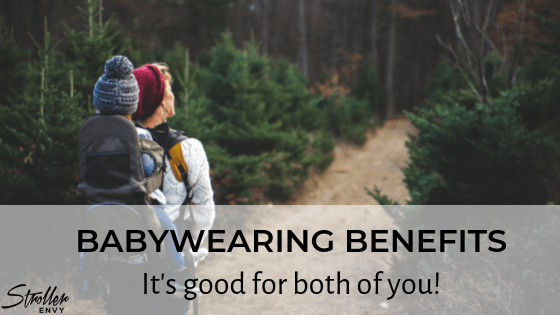You may have seen parents carrying their infants in specially designed slings or baby carriers and wondered what all the fuss is about. After all, babywearing is just about the most popular childcare phenomenon of recent years.
So, here are 11 of the many benefits that babywearing can bring for both caregiver and child, according to medical and pediatric professionals.
Table of Contents
Strengthening the bond
Babywearing and the closeness that it creates between you and your little one throughout your day helps to strengthen the bond between you and your child, especially during the early days of the “fourth trimester.”
It’s thought that the baby tunes in to the familiar rhythm of the mother’s heartbeat and breathing, helping to replicate the closeness that was experienced while in the womb.
Aids your baby’s development
Babywearing helps to promote healthy development in babies, both emotionally and physically. A carried baby is generally more relaxed and calmer because her primal needs are met.
Promotes speech and neurobehavioral development
Babywearing gives the baby a continually changing view of the world around them. Rather than lying flat all day, staring at a limited view from a crib.
Carried babies experience a whole gamut of different emotions, facial expressions, and voices, all of which is invaluable for the child’s neurobehavioral development.
A carried infant will hear more language. And the more words a child hears, the wider his vocabulary will be when he reaches toddlerhood.
Decreases flat-head syndrome
A carried baby is less likely to suffer from conditions such as flat-head syndrome (plagiocephaly) and the associated Sudden Infant Death Syndrome (SIDS).
Plagiocephaly is the correct medical term for a condition that’s also known as “flat-head syndrome.” Flat-head syndrome occurs when a baby spends many hours each day sitting in an infant seat or lying flat in a crib. The continual pressure on the back of the skull can cause the back of the baby’s head to flatten.
Using a baby carrier can effectively prevent plagiocephaly and SIDS, which is also seen in babies who spend much of their day lying flat.
Health benefits
Babywearing can help in a baby’s neural development, gastrointestinal and respiratory health, and balance.
Discreet breastfeeding
Babywearing allows moms to breastfeed their infants discreetly while on-the-go.
Increases breast milk production
The close contact of a mother with her baby that’s provided by babywearing helps to boost breast milk production.
Hands-free advantages
Babywearing allows caregivers to remain hands-free while still holding their child. That means you can get more done; it’s really multi-tasking and then some!
Baby’s eye view of the world
Babywearing allows the infant to discover their new world from the safety and comfort of their parent’s body.
Carried babies cry less
According to research, babies who are carried are more content and less likely to be “criers.” The close contact between an infant and his parent is proven to settle a “fussy” baby, whereas confining him to a crib can make the problem worse.
Promotes physical development in infants
The upright positioning of a child in a sling or carrier helps to develop neck strength and head control. If the child’s arms are held against the parent’s chest, the baby will push against it, strengthening the arms.
When a baby is placed flat in a crib or baby seat, there is not the same opportunity for physical development as there is in a carrier.
Also, the continual motion of being carried helps to promote the child’s inner-ear development and balance.
Wrapping Up
So, you can see that babywearing has many benefits for both the caregiver and the infant.
As well as the strengthening of the bond between parent and child, babywearing helps the infant’s physical and mental development and can reduce the risk of certain health conditions.
Sources:
https://www.bbc.co.uk/news/uk-scotland-south-scotland-31821809

